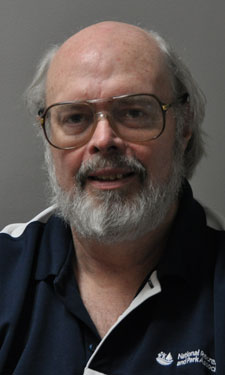 Bill Beckner is one of the lions of NRPA. A member of our association since 1972 and a staffer since 2009, Beckner brings with him a wealth of historical and practical knowledge and a strong, grounded perspective on the value of research. During his long career, Beckner spent time organizing recreation for the United States Air Force, earned his master’s degree in park and recreation administration, worked as an interpreter for the National Park Service, and made invaluable contributions to park and recreation efforts in Virginia’s Fairfax County. Here at headquarters, it’s a matter of course that if you’ve got a question about our industry, Beckner likely has your answer. We caught up with NRPA’s senior research manager at his home near the Smithsonian National Zoological Park in Washington, D.C., and just scratched the surface of all the insights our own human encyclopedia has to share.
Bill Beckner is one of the lions of NRPA. A member of our association since 1972 and a staffer since 2009, Beckner brings with him a wealth of historical and practical knowledge and a strong, grounded perspective on the value of research. During his long career, Beckner spent time organizing recreation for the United States Air Force, earned his master’s degree in park and recreation administration, worked as an interpreter for the National Park Service, and made invaluable contributions to park and recreation efforts in Virginia’s Fairfax County. Here at headquarters, it’s a matter of course that if you’ve got a question about our industry, Beckner likely has your answer. We caught up with NRPA’s senior research manager at his home near the Smithsonian National Zoological Park in Washington, D.C., and just scratched the surface of all the insights our own human encyclopedia has to share.
Parks & Recreation Magazine: You’re currently NRPA’s senior research manager — what appeals most to you about this role?
Bill Beckner: Our focus is on game-changing applied research that assists people in the field to be more cost-effective and productive. Whether people pick up on the data opportunities or not, it is now available to them. I have been a manager; I have been a director. The closer I get to retirement, the more I want to do things that are challenging and fun. If I could, I would go back to interpretation. That is what I enjoyed most in my career.
P&R: You were instrumental in NRPA’s adoption of the Social Equity pillar. Tell us about the process of adding that piece and why you felt it was essential.
Beckner: During the middle 2000s, NRPA held three summits. One was on urban conditions in Chicago, the second was for health and wellness in Atlanta, and the last was for conservation in Portland, Oregon. In my first year, I noticed that [NRPA] was having trouble getting grants as well as having difficulty defining for the membership what NRPA stood for. [Former vice president of membership and professional development] Tara Fitzpatrick-Navarro and I discussed the lack of a visible purpose for NRPA. We decided that when asked, “What does NRPA stand for?” the answers were murky and diverse. So Tara dug out the summit policy statements, and various people had input into the language for the three areas, later named pillars. I had consulting contracts in Cincinnati and El Paso and had a good feel for the social equity issues that existed. I drafted a version of social equity and passed it on to others.
P&R: What is the most exciting/intriguing project on which you’ve worked at NRPA?
Beckner: Without any doubt, PRORAGIS is the most challenging of all my projects. It also has the most potential and can be the most rewarding, although it is frustrating at times.
P&R: Why do you feel research is vital to our industry?
Beckner: The old cliché is that if you can’t measure it, it is not worth doing. We can measure our progress, we just don’t do it intuitively. In 1975 when inflation was high, my job was on the cutting block. I was given the chance to speak, and lacking data gave an eloquent opinion on the value of the job. They cut my job because in their opinion the position didn’t have data to support my opinion. The lesson? The highest-ranking opinion will always win when there are no facts available.
P&R: What advice can you offer park and recreation agencies/professionals working today?
Beckner: 1) People like to do what they do well! 2) Introduce as many people to as many different activities as possible, 3) Give those folks the opportunity to learn the skills necessary to do well at the activity, and 4) Provide recreational participation opportunities so the participants may enjoy the activity. Happy, active participants will support your department against all comers.
Samantha Bartram is the Associate Editor of Parks & Recreation Magazine.

